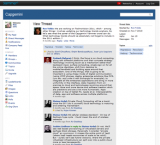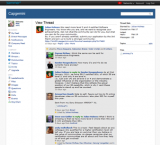A few years ago we launched a “microblogging” system called Yammer at Capgemini. Yammer is a private and secure enterprise social network that allows colleagues to hold conversations, read posts and actively collaborate with co-workers in real-time. It is contributing to the collective consciousness of the 25,000 people who subscribe to it, a consciousness that is continually shifting and updating, as those people constantly learn and share new experiences.
Capgemini has over 110,000 employees dispersed across the world in high level consulting, technology and outsourcing positions. Many of these people are based on site at client locations. The IT consultants in particular, who form about half of the workforce, are in an environment where much of the information they use goes out of date very quickly, yet is also very specific to a product, or a situation
A key challenge for us is how to keep our disparate colleagues up-to-speed, and able to benefit from all of our massive amount of in house knowledge in order to optimise delivering value to our clients. Does social networking provide part of the answer?
Back at the end of 2008 some colleagues had locally founded a small Yammer community, and based on their successes, and the growing numbers by early 2009 it looked a more promising approach than our then practice of using email community lists to exchange information. The then members were carefully using the externally hosted Yammer service for pure technical topics in their own time as our Enterprise rules forbad using an external service for Capgemini or Client business. Discussions up to and including our CEO, and CIO, resulted in the establishment of a code of practice on use and the decision to allow the membership to increase organically by those who personally decided that Social Networking would help them. From these small beginnings by the end of 2009 there were more than 5,000 members and the benefits achieved warranted a mention in the Capgemini annual report for 2009 in the spring of 2010.
How has Yammer made a difference to the ‘Collaborative Experience’ that we seek to provide to our clients as a way of differentiating ourselves? In large part it is about decentralising the information flow, to create greater collaboration from the outside in. Whereas previously information dissemination was all about the centralised business and knowledge management, social networking has caused a shift in the way we communicate: it’s about an event, a topic, a specific information need at the point of service delivery, such as on site at a client facility.
It is those consultants at ‘the edge’ who are posing the questions and using Yammer. They’re encountering a lot more variability in what they’re being asked to do than perhaps those at the centre of the organisation who are driving the more structured approach of our business to the market. They’re using it as a service enabler; a tool to help them do more by tapping into a corporate knowledge bank in real time. Of course, its also vital that those of us at the centre climb aboard as well. The threads (conversation streams) that are generated on Yammer provide vital insight into what’s going on across our business. They are our best chance to see what’s happening on the front line and for our executives to ask questions that might help shape future strategy.
The concept of threads, or streams of conversation on a specific topic, is a key feature of Yammer. A thread shows all the replies to a specific message underneath the original update, making it easier to follow conversations. In fact, Capgemini’s CEO is known to regularly go on to Yammer and check out who the top thread followers and creators are and what they’re discussing. Other board directors have made “YamJams”, webcasts where Yammer works as a back channel for people to hold ask questions while the executive concerned is presenting, or to send comments directly to the presentation during the YamJam in real time. The benefit of this is that the thread members see each other and it allows new relationships to form around aspects of the YamJam.
Interest in Yammer amongst a wider and less directly technical community increased after it was used by the head of internal communications to provide real time summaries of sessions at the bi-annual Capgemini senior management meeting, and to permit users to directly add their questions to those of the attendees at the end of a session. In short the use of the tool as a major part of real time communications improvements also began to feature senior managers using the capabilitiy though in truth most of them are still wary of the format for their everyday personal use. We have a wide range of threads, largely business-focused, but a number with more social intentions. Today studies have shown that more than 80% of the messages are strictly business, 4% can be truly classified as nothing to do with business, and the balance are ‘discussions’, but that’s okay too, as you do need some social interactions to make a social network interesting!
People who use Yammer have become a social group in themselves meaning that what and how they interact has evolved with social rules to optimise the medium. They use it to ask the pertinent questions online in real time, such as who is responsible for a particular project or whether anyone has experienced a similar technical issue, and then at a certain stage if it is a detailed matter the three or four people actively supporting the thread may move off Yammer to use a further collaboration tool set for real work. Equally threads may link to and tell others that the required information is in the Capgemini Knowledge Management system, the social networking integrates to the other tools. Though increasing it seems it is the Social Network element that acts as tthe social glue that holds it all together.
There are three distinct groups of users within Capgemini: hugely active; regular Yammers; and listeners. The hugely active group comprises around 50 people, many of whom were involved when Yammer was first piloted within the organisation. They tend to be top Capgemini smart technology people who are keen to stay on top of their game by constantly asking questions and responding to Yammer threads. They’re managing communities and ensuring that Yammer is an active place and working all the time. The group of regular Yammers is comprised of about 800 users. They’re not as passionate about Yammer as the active users but are likely to feel that if they haven’t been on for a couple of weeks, they’re missing out on something. Then there are the ‘listeners’, those users who perhaps use Yammer for a specific purpose, to follow a thread about a topic that resonates with them, but without the need to add their own comment unless something particularly of personal value occurs. They know it’s there and can dip in and out as and when they need to.
These ratios seem to be about normal for successful social networks and they hide the huge importance of the so called ‘core’ people in making a network successful. Social Networks fail without a core group making them active and interesting, yet all to frequently this core is seen as too dominant and limiting therefore allowing an unenlighted management to state that a pilot is unsuccessful as the active numbers are too low.
Problem solving is the biggest area of usage, with Yammers asking for support or help in tracking down a colleague or information resource. One thread starts with the request: “We need more Level 3 and 4 Certified Software Engineers” the discussion becomes how to encourage training and certification from colleagues. Other threads revolve around building communities of interest on a particular topic, such as “We are working on Technovision 2011 (a thought leadership publication). What Technology trends should we absolutely not forget to include?” There is also a sense that Yammer can support innovation.What we see is ideas from one part of the business being picked up and applied in different sectors. So it’s stimulating innovation in a certain way, through the reuse of best practices but in an entirely different context.
One surprise has been the speed at which threads grow. It’s almost a kind of outsourcing allowing questions to be asked outside the constraints of your business group whereby you ask a question and one, two or three or four people will come back with some take on the answer. And unlike email, which is targeted to a group of people you already know, a Yammer request goes out to anyone interested in a topic. Very quickly, you’ll have a discussion underway that may involve six to ten people as they debate the issue and work it. The speed with which people join and extend the thread is remarkable. This sort of interaction is simply not possible within the constraints of email.”
We have to adhere to a few controls put in place to safeguard client information and competitive intelligence. As social environments change so fast, a traditional set of governance policies would strangle the benefits of flexibility. Instead, we have developed a code of conduct to make employees aware of the consequences of using a tool such as Yammer. The code starts with a mission statement: Yammer is “a source of instant inspiration to strengthen and empower its members to face their daily impediments and foster the development of international social networks around common areas of interest”. It builds on such values as honesty, boldness, trust, freedom and fun. And, importantly, because Yammer is hosted by an independent company, not by a central IT department, no confidential or client-specific matters are discussed.
Usage tends to be self governing, so if someone Yammers with information they shouldn’t, other users will urge them to stop. We can’t control the growth of Yammer but if it does continue to expand, we may need to increase the level of formalisation in some way or another, currently we are looking at improving the integration with other internally hosted tools for collaboration to move specific and detailed discussion forward in our secure internal systems. Capgemini’s use of Yammer has evolved as membership has increased, for instance with the introduction of a benefit tracking mechanism; a thread that elicits a good or rapid response or a clear benefit can be tagged to draw it to other users’ attention. The clear point is that it is driven by the users developing the direction and capabilities to suit their needs.
Understand the limits of technology. No single technology will ever meet the full array of needs that a large company. The evidence is that Yammer is good for solving specific problems, sharing information quickly, and generating immediate buzz on a topic. But it is not so good for other things. Yammer isn’t very well suited for distributing traditional structured information that doesn’t change very often; and for most colleagues to really collaborate with each other in a structured way is also difficult.
So if you picture a spectrum of increasingly complex and interactive tasks in a big company, Yammer works best in the middle of that spectrum – at the low end, the basic sharing and archiving of structured information is done best using traditional knowledge-management databases, and at the high end, if you want to brainstorm about developing a new service offering or solving a tricky problem, a face-to-face meeting is likely to be your best bet. But there is an increasing range of tasks in the middle of that spectrum which require too much interactivity for traditional IT systems, and where you cannot justify the cost of a face-to-face meeting. This is the sweet-spot for social networking tools, and it corresponds to the shift that we see in the market towards the success coming from optimising responses to real time events around unstructured information.
Management’s changing role. Consider the list of things that we use Yammer for: aligning activities, problem solving, information sharing, providing clarification. Now think about the things managers do for a living – and you quickly end up with a pretty similar list. Social networking technologies, in other words, are increasingly being used to provide the support and input that employees used to get from their managers. In other words, they are taking away some of the more mindless activities that managers used to perform, freeing up their time to do the real value-added work – such as motivating their employees, structuring their work to make it more engaging, developing their skills, securing access to resources, and making linkages to other parts of the organisation. Interestingly many managers today feel unable to perform this role as they are too busy with email so its important to note that among many of the top technical staff (including ourselves), email has dropped substantially with 40% reductions being about the norm in this group.
Blurring the boundaries between work and play. When social networking sites first came on the scene, most companies banned their use at work – they were seen not only as a security threat, and they were also seen as a distraction from real work. But the boundaries between social networking sites and corporate Intranets are blurring all the time, and Yammer is just one of many technologies that sit in this grey zone between the two worlds. And the boundaries are murkier still in the minds of employees, many of whom feel it is entirely appropriate to blur their work and home lives. The Capgemini CEO used this change as a topic for his prestigious keynote early in 2011 at CeBit, Hanover.
Indeed, Yammer encourages a mix of the practical, the profound and the trivial. One thread started with the question “When did anyone last buy a tie?” And the World Cup 2010 attracted a great deal of traffic. It’s the equivalent of the local water cooler or coffee machine in promoting interactions and most people when asked where they get information from quote these as sources amongst others!
So we don’t see the social use of Yammer as something that will interfere with work. This is perhaps a sign of the maturity of our communications platform in that we’re happy for a sporting or other interest group to be part of Yammer. It is, after all, ‘social’ networking technology.”
As a means of connecting a disparate workforce Yammer is proving its worth at Capgemini. It maintains a largely business focus, acting as a pool of best practice and offering experience from the front line. It allows people working on similar assignments to connect with colleagues they may not have been aware were working in the same field. It acts as a conduit, feeding in information from the edge of the business to transform the whole process of internal communication. This is social networking with an enterprise signature.
Good update Andy ! Yammer is indeed a core part of the Knowledge eco-system at Capgemini
- Log in to post comments
Success by increments - step by step and day by day - it work's
- Log in to post comments
This is a great article, Andy. I am particularly interested in you comments about your users "self governing" and watch each other to ensure there is no information shared on Yammer that shouldn't be. I'm wondering about your needs I this area as well as overall analytics that provide information on the activity and usage of your Yammer network. I am the principal product manager for a product called ViewPoint (http://Axceler.io) that provides visibility across multiple enterprise social networking products. Customers I have talked say that this visibility is important. I'd love to hear your thoughts...
- Log in to post comments
Outsourcing is becoming more and more competitive for these past few years and because of that many outsourcing firms are integrating new strategies and ideas and a part of it is dispersing talented and skilled people in order to cater services internationally or globally. Outsourcing has been very helpful to some business and some of them are now very successful and widely known around the world. Outsourcing has benefits and advantages.
- Log in to post comments






You need to register in order to submit a comment.